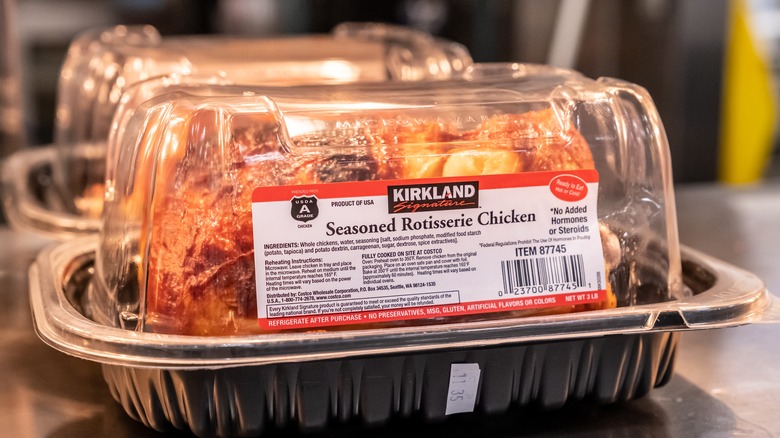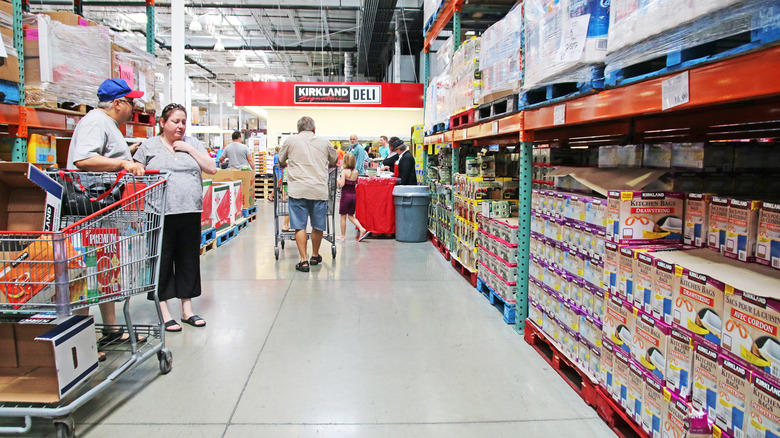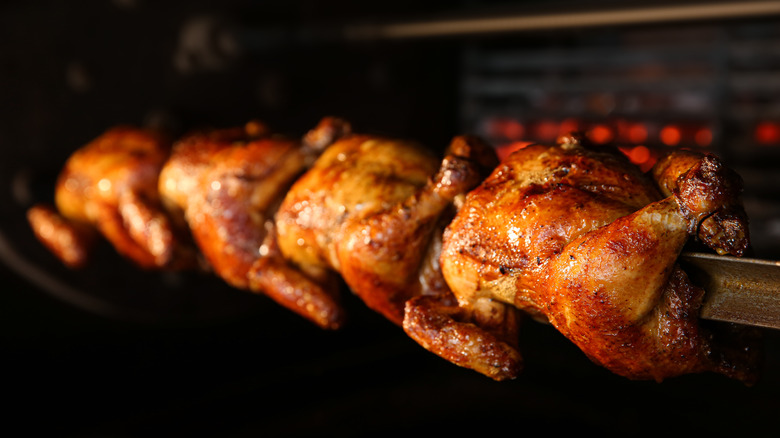How Costco's Rotisserie Chickens Stay $4.99 Despite Inflation
Bargain hunters and busy households are quick to sing the praises of Costco's rotisserie chicken. The succulent bird is not only known for its taste but for its price. Since launching nearly 25 years ago, the price of the item has remained just under $5 almost the entire time (in 2008, it increased by a dollar for one year). To date, it remains a leader in the affordable poultry race and, to some economists, a barometer for the worst of inflation.
Shoppers may wonder if the brand has cracked the secret to raising cheaper birds. After all, the company did start its own chicken farm to save on costs. As of 2019, Costco took control of the production, packaging, and selling of poultry to save on costs, an example of vertical integration. Instead of farm to table, the company manages to touch every step from farm to heat lamp.
Taking the process in-house reduced the price to the company by $0.35, but that can't match up against the cost of feed and labor. The reality is, Costco keeps its rotisserie meat affordable because it's willing to take a $30 to 40 million financial hit to entice its 73 million members. The stores lose money on the item, rather than scramble to beat inflation, but they see the item as a tool to make back the cash in other ways.
Chicken gets shoppers in the door
America's most popular protein sells. An estimated 950 million rotisseries are eaten every year, and the membership-based company reportedly sold 137 million of them last year. The company is known for putting out a boxed offering that's comfortingly tasty and reliably fresh — even more so for savvy bargain hunters who rush the counter when the Costco bell chimes, and spot the new batch of rotisseries ripe for the taking.
Costco sells the cluckers at a loss — they're worth nearly double the price — to get feet in the door, rather than making an immediate profit. Business experts like to point to the item as an example of a "loss leader." These are products that attract shoppers and are found in the very back of the store, drumming up spending by placing other desirable items within eyesight along the path.
Word of mouth and a buzzy, beloved kitchen workhorse is in good company. Members also count on the famously cheap $1.50 hot dog and soda combination that also remains at the same price as it was in the '80s. However, unlike rotisserie chickens, which are a breeze to reheat, those snacks are best eaten fresh.
The state of rotisserie chicken
Costco isn't the only retailer known to peddle a succulent cooked bird. Other stores offer their take on the rotisserie, offering plain and seasoned proteins that can feed a family, hold their own in tacos and salads, and serve as the foundation for soups. Although the Kirkland $4.99 price is near impossible to beat, mom-and-pop groceries and smaller chains often offer the prepared food at a lower price than the raw stuff.
This may be because they're made using unsold merchandise. Rather than allowing carcasses to expire, groceries will send the extra poultry to the prepared food department to hit the rotating spit. Prices are more vulnerable to inflation and a few dollars more than Costco, but it's a savvy method of salvaging lost sales. Plus, like the budget chain, these stores can encourage shoppers to add other dinner items to their cart while they load up.
That said, while the Costco bird tops the list of best rotisserie dinners, but it's not without its costs. In years past, some fans came forward to say the item had an unusual soapy taste, possibly a result of some of the preservatives used to make it. Activists also sued the brand for its treatment of the animals, though its farming practices are on par with the industry standard and the company declined to change its process. For now, many members remain unfazed and continue patronizing the beloved wholesale club to take advantage of the deal.



